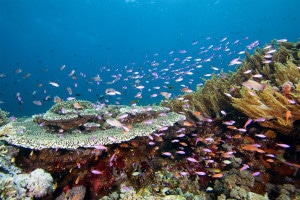Tropical fish and corals insufficiently protected
A recent study shows that the global network of marine protected areas is insufficient to preserve the biodiversity of corals and tropical fish.

We already knew that marine life is threatened by human activity. Fortunately, "marine protected areas" have been set up all over the world. Today, there are 3,625 coral reef protected areas, covering a total surface area of 942,568 km2 (5.9% of the world's coral reef surface). These areas, where human activities are regulated, meet nature protection objectives and are refuges for ecosystems and their biodiversity.
Trees of life" only partially preserved
But is this really the case for biodiversity as a whole? As far as fish and corals are concerned, the verdict is in: on a global scale, many species are insufficiently protected by these refuges. In an article published in Nature Communications on January 12, researchers from the University of Montpellier, IRD, EPHE and CNRS demonstrate that the global network of marine protected areas is insufficient to conserve the diversity of the genetic heritage of corals and tropical fish. This diversity is fundamental to the long-term functioning of coral ecosystems.
The international team of researchers led by David Mouillot, professor at the University of Montpellier and in the UMR MARBEC, studied the geographical distribution areas of 805 coral species and 452 fish species, and looked at their coverage by the global network of marine protected areas. It also looked at the level of protection afforded to the "tree of life" - i.e. the genetic diversity - of these species. The result: only 1.7% of the coral tree of life and 17.6% of the fish tree of life meet the minimum thresholds for coverage by protected areas to ensure their preservation.
Poorly distributed areas
"Marine areas only protect closely related species, i.e. from the same families. Other species families receive little or no protection," sums up David Mouillot. The reason is simple: in the absence of a global conservation strategy, marine protected areas are very unevenly distributed across the planet. While there are many around Europe, or between Australia and New Caledonia, for example, there is a significant deficit in the South, particularly in the Caribbean and Africa.
These disparities often reflect inequalities in economic development, but also political will: in the northern hemisphere, and for developed countries with a strong environmental commitment, the protection effort is substantial, whereas in the southern hemisphere, certain countries are lagging behind in the actions they have taken. "We need to refocus the creation of new areas on priority zones: regions with a concentration of ancient and poorly protected lineages, highly exposed to human activities, particularly in the Atlantic, South-East Pacific and Indian Oceans," asserts David Mouillot. "To preserve the genetic heritage and functioning of ecosystems, areas must now include the evolutionary history of species in their objectives".